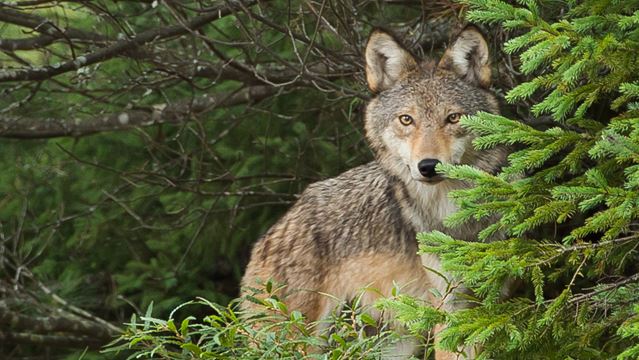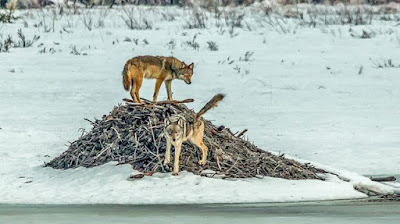https://www.google.com/url?rct=j&sa=t&url=http://www.muskokaregion.com/community-story/6746390-elusive-algonquin-wolf-is-officially-a-threatened-species/&ct=ga&cd=CAEYACoTNzc5MzQ4MjUyNzQ0ODU2NTAwMDIaYzE4NDBkZjEzZWE0YjE4ZTpjb206ZW46VVM&usg=AFQjCNEMgUcn0gP1S7H6DpiPr-HKiCHCkg
Elusive Algonquin wolf is officially a threatened species
With fewer than 500 left in Ontario (or somewhere between 250 to 1,000 – nobody knows for sure), the majority of wolves live in the park’s protected forest, says a provincial report. Some roam in the regions surrounding Algonquin, like Muskoka, but it’s unknown how many have survived hunting and trapping, habitat loss and road-related mortalities.“Most times the wolf is there, then gone, like a ghost,” said Wesley Liikane, a Severn Bridge photographer. He snapped a picture of an Algonquin wolf when he was hiking in the southern part of Algonquin Park.
Elusive Algonquin wolf is officially a threatened species
Jun 29, 2016
Samantha Beattie is a reporter with the Gravenhurst Banner.
MUSKOKA – If you’re lucky enough to catch a glimpse of an Algonquin wolf, the experience will be surreal and brief, especially now the species is moving closer to extinction.
With fewer than 500 left in Ontario (or somewhere between 250 to 1,000 – nobody knows for sure), the majority of wolves live in the park’s protected forest, says a provincial report. Some roam in the regions surrounding Algonquin, like Muskoka, but it’s unknown how many have survived hunting and trapping, habitat loss and road-related mortalities.“Most times the wolf is there, then gone, like a ghost,” said Wesley Liikane, a Severn Bridge photographer. He snapped a picture of an Algonquin wolf when he was hiking in the southern part of Algonquin Park.
In June, the Ontario Ministry of Natural Resources and Forestry upgraded the statusof Algonquin wolves from a species ‘of special concern’ to ‘threatened.’ With official acknowledgement wolf populations are dwindling, the province is granting the wolves more protection.
"They have a certain weary way of looking at you, considering if they’re going to make a move to disappear.” -- Hannah Barron, Earthroots
“As a threatened species, the Algonquin wolf automatically and immediately receives protection from harm and harassment and protection of the habitat on which it depends,” said MNRF spokesperson Jolanta Kowalski.
That means hunting Algonquin wolves is now prohibited throughout all of Ontario, she added.
Since 2004, wolves and coyotes have been protected from hunting and trapping within Algonquin Park and 42 surrounding townships, said Kowalski. Outside this region, however, hunters are still allowed to kill coyotes and other animals like Great Lakes-Boreal wolves, Eastern coyotes and hybrids that look virtually identical to Algonquin wolves.
Wolf advocates do not think this hunting policy makes sense.
“Algonquin wolf recovery requires a government commitment to protect the eastern coyotes they live alongside and are often confused for,” said Coyote Watch Canada’s Lesley Sampson.
“Algonquin wolves are largely unable to find a mate of their own kind, and more commonly mate with eastern coyotes. This interbreeding makes it impossible to tell the difference between the two animals without a genetic test.”
The MNRF doesn’t require these tests to be done and “has no idea” how many wolves are being killed, Sampson said.
Hannah Barron, director of the grassroots conservation organization Earthroots, used to research Algonquin wolves for Trent University. A few years ago she had the “unglamorous” job of collecting genetic material from what appeared to be wolf urine, skat and blood to figure out where they were living.

“In between Huntsville and Parry Sound there are probably some wolves, but we don’t know where,” Barron said. “If someone saw a wolf in the Huntsville area they wouldn’t be able to say if it is a wolf or a coyote without doing a genetic test.”

“In between Huntsville and Parry Sound there are probably some wolves, but we don’t know where,” Barron said. “If someone saw a wolf in the Huntsville area they wouldn’t be able to say if it is a wolf or a coyote without doing a genetic test.”
Until this year, the Algonquin wolf was called the Eastern wolf. The name change reflects the wolves’ long history of mating with other Eastern wolves, Grey wolves and coyotes, reports the Committee on the Status of Endangered Wildlife in Canada.
The hunting and trapping season for coyotes and wolves is open year round in areas south of Muskoka. From Muskoka and north, hunting and trapping is restricted to Sept. 15 to March 31.
“The MNRF minister has made no moves to clarify how Algonquin wolves will be protected from hunting,” said Barron. “I’m really concerned about what will happen if hunting of wolves and coyotes is allowed to continue.”
Barron will never forget when she saw what could be an Algonquin wolf just outside the park.
“It was wonderful,” she said. “They have a certain weary way of looking at you, considering if they’re going to make a move to disappear.”
What Algonquin wolves look like:
While Grey wolves living in boreal forest north of Lake Superior are large and can be all black or all white, Algonquin wolves are relatively small and typically have reddish-brown muzzles, ears and lower legs, according to Algonquin Park research. Their backs are a mix of black, white and grey. On average males weigh about 66 pounds and females about 55 pounds.
Where they live:
Algonquin wolves typically live in deciduous and mixed forests, says the province. They are found in areas with an abundance of prey like beavers, white-tailed deer and moose. Dens are often built in sandy areas, with conifer trees and permanent water sources.
Ontario is home to the majority of Algonquin wolves, but they are also found in Quebec.
How they form packs:
Pack sizes change from year to year due to new pups, mortality, immigration of new wolves to the area and dispersal of exiting members, says Algonquin Park. Each pack usually has a territory of about 150 square kilometres.
The average pack size is five to seven wolves. Every May about four pups are born to each pack. Within the first year of life, pups usually disperse to find new packs.
Who their predators are:
Algonquin wolves have to be wary of bears, other wolves and most of all humans. The Committee on the Status of Endangered Wildlife in Canada lists hunting and trapping as the biggest threat to wolf populations. Other threats include contracting mange and rabies, getting hit by vehicles and loosing habitat and therefore food sources.










No comments:
Post a Comment